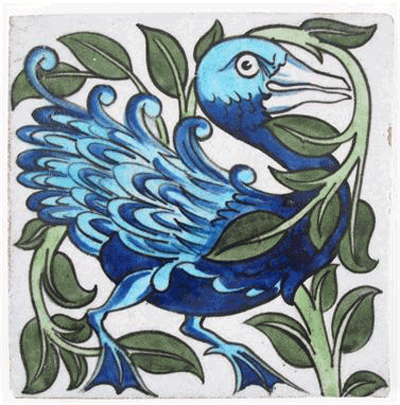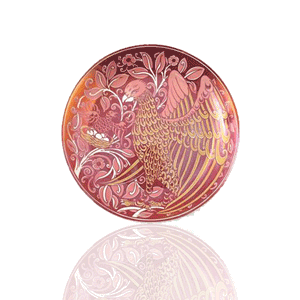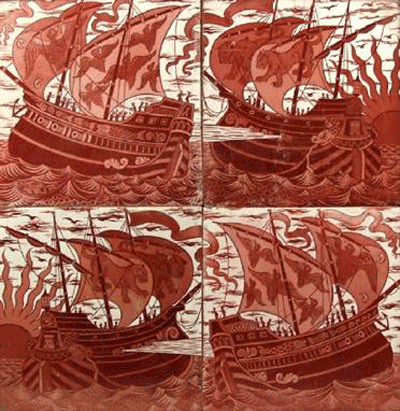WILLIAM DE MORGAN: HISTORY & VALUATIONS
Text content
Have you ever wondered what your William De Morgan Ceramic is worth?
Find out more about the history of William De Morgan and get in touch using the form below for a free valuation.
How we can help you sell your William De Morgan Ceramic
Pieces from William De Morgan are highly collectable. If you have a piece or pieces by William De Morgan and would like to find out more about the artist please read our guide to De Morgan’s history at the end of this page.
Please use the enquiry form on this page to send us details and pictures of your De Morgan ceramic for a free valuation and information on selling your ceramics.
The Market for Arts & Crafts in 2020
The market for Arts & Crafts pieces, especially that of William De Morgan, has grown steadily over the years.
There is now more than ever an appreciation of the role of the artist or maker, with people buying pieces of William De Morgan simply as it is by William De Morgan. Prices continued to increase in 2019 with the rarest forms commanding the highest prices.
More than ever condition is key and collectors discriminate against even the smallest imperfection.
Free Valuations on Your
William De Morgan
Auction or Private Sale?
If you are deciding on how to sell your William De Morgan ceramics we can have a no obligation chat on the best options for you. We can either make a personal introduction to the best saleroom based on your location and item free of charge. Or we can look into collecting you some no obligation offers for a private sale, which could save you considerably in commission.
In a nutshell here are the main pros and cons of each option:
- Auctions can provide an increased market exposure (when you choose the right saleroom) but their gross fees can reach as much as 50%, and the payout times can be drawn out.
- Private sales leave you in control of the price, and can be completed quickly but there is no chance of ‘buyers fever’ driving up prices.
Mark Littler Ltd. are one of the only independent advisers in the antique industry. We offer trusted, independent advice to help you sell your ceramics for the highest possible price.
Receive a free valuation for your William De Morgan ceramics
Where possible please send us a picture of your piece as this will help speed up the process of giving you a valuation.
Selling your William De Morgan with Mark Littler Ltd.

Send us details about your silver directly via email or use the form below.

We contact our international network of customers for the best offers.

If you decide to proceed with an offer we issue you with a contract.

Send us your silver. We have a fully insured courier service available.

We complete the sale with the buyer and send your funds via BACS.
William De Morgan History
William De Morgan was one of the most prominent ceramic artists in the world and a leader in the Arts and Crafts Movement.
Born in 1839 to a French family of renowned intellectuals, his father was a mathematics professor, and his mother was active in the early 19th-century suffragette movement. In 1859 De Morgan attended the Royal Academy School, where his classmates included Frederick Walker, Simeon Solomon and Henry Holiday. It was through Holiday that De Morgan would meet his lifelong friend and business partner William Morris, who would ultimately greatly influence his works and life.
In 1863 De Morgan began to shift his attention to decorative arts. He designed tiles, stained glass and furniture for Morris. & Co. until 1872. Along with painter Edward Burne-Jones, De Morgan and Morris had a prosperous business relationship that spanned for many years.
In 1872 a fire in his studio led De Morgan to create his own a pottery space and firm in Chelsea.


Reviving Lustreware
De Morgan generally did not throw or paint the pots, rather he decorated them. His innovative spirit and sensibilities led him to examine every technical facet of his art. Curious and inventive by nature, he was consumed in analysing the chemistry of glazes, firing techniques, and how to transfer patterns.
His patterns could be identified by their depiction of galleons and fish, which were a favourite motif of his, as were outlandish birds and other animals. Many of De Morgan’s tile designs were created with the intention that lain together, would create a complex and elaborate pattern.
The time in his own studio was the period when De Morgan revived the lustreware technique.
Lustreware was a considered a dangerous technique in which a thin metal film is coated on the surface. It creates an iridescent effect whose colours would glimmer depending on how light was reflecting on it. The technique originated in the Middle East however De Morgan was responsible for reviving this technique, as well as advancing its use.
Signature colours
It was around the year 1875 that De Morgan began to create what he referred to as Persian colours, which were inspired by 16th-century Turkish pottery in Iznik. Filled with lush shades of blues, reds yellows, greens and purples, De Morgan applied to these works his signature abstract and floral designs. Throughout his life, he remained influenced by this Turkish artistry.
In 1882, De Morgan’s business was growing, and his pieces were in demand. Moving into a larger space, he began to increase production of vases, bowls and dishes. His magnificent animals and intricate floral motifs would continue to be significant subjects in his works, thanks to the influence of his friend William Morris.
However, it wouldn’t be until 1888 that De Morgan would leave his lasting mark upon the world. Beginning a ten-year business relationship with architect Halsey Ricardo, during this period De Morgan would create some of his most astounding and unforgettable works. Infused with a rich aesthetic and more sophisticated designs, he created the masterpiece “Sunset and Moonlight Suite”, triple-lustred dishes made of gold, silver and copper.
Eventually health issues drove De Morgan to move to Italy, he had all but abandoned his pottery business with Ricardo when it eventually closed in 1907. De Morgan still found success as an artist, this time as an author. His debut novel “Joseph Vance” would become an international sensation, and he followed with several more best sellers.
De Morgan will forever be recognised for his imaginative artistry and well as his technical advancements in pottery. His contributions include new decorative techniques and he refined kilns as well as other equipment. His works can be found in the Victoria and Albert Museum, The De Morgan Centre and other exhibits.

Receive a free valuation for your William De Morgan ceramics
Where possible please send us a picture of your piece as this will help speed up the process of giving you a valuation.
Have you ever wondered what your William De Morgan Ceramic is worth?
Find out more about the history of William De Morgan and get in touch using the form below for a free valuation.
How we can help you sell your William De Morgan Ceramic
Pieces from William De Morgan are highly collectable. If you have a piece or pieces by William De Morgan and would like to find out more about the artist please read our guide to De Morgan’s history at the end of this page.
Please use the enquiry form on this page to send us details and pictures of your De Morgan ceramic for a free valuation and information on selling your ceramics.
The Market for Arts & Crafts in 2020
The market for Arts & Crafts pieces, especially that of William De Morgan, has grown steadily over the years.
There is now more than ever an appreciation of the role of the artist or maker, with people buying pieces of William De Morgan simply as it is by William De Morgan. Prices continued to increase in 2019 with the rarest forms commanding the highest prices.
More than ever condition is key and collectors discriminate against even the smallest imperfection.
Free Valuations on Your
William De Morgan
Auction or Private Sale?
If you are deciding on how to sell your William De Morgan ceramics we can have a no obligation chat on the best options for you. We can either make a personal introduction to the best saleroom based on your location and item free of charge. Or we can look into collecting you some no obligation offers for a private sale, which could save you considerably in commission.
In a nutshell here are the main pros and cons of each option:
- Auctions can provide an increased market exposure (when you choose the right saleroom) but their gross fees can reach as much as 50%, and the payout times can be drawn out.
- Private sales leave you in control of the price, and can be completed quickly but there is no chance of ‘buyers fever’ driving up prices.
Mark Littler Ltd. are one of the only independent advisers in the antique industry. We offer trusted, independent advice to help you sell your ceramics for the highest possible price.
Receive a free valuation for your William De Morgan ceramics
Where possible please send us a picture of your piece as this will help speed up the process of giving you a valuation.
Selling your William De Morgan with Mark Littler Ltd.

Send us details about your silver directly via email or use the form below.

We contact our international network of customers for the best offers.

If you decide to proceed with an offer we issue you with a contract.

Send us your silver. We have a fully insured courier service available.

We complete the sale with the buyer and send your funds via BACS.
William De Morgan History
William De Morgan was one of the most prominent ceramic artists in the world and a leader in the Arts and Crafts Movement.
Born in 1839 to a French family of renowned intellectuals, his father was a mathematics professor, and his mother was active in the early 19th-century suffragette movement. In 1859 De Morgan attended the Royal Academy School, where his classmates included Frederick Walker, Simeon Solomon and Henry Holiday. It was through Holiday that De Morgan would meet his lifelong friend and business partner William Morris, who would ultimately greatly influence his works and life.
In 1863 De Morgan began to shift his attention to decorative arts. He designed tiles, stained glass and furniture for Morris. & Co. until 1872. Along with painter Edward Burne-Jones, De Morgan and Morris had a prosperous business relationship that spanned for many years.
In 1872 a fire in his studio led De Morgan to create his own a pottery space and firm in Chelsea.


Reviving Lustreware
De Morgan generally did not throw or paint the pots, rather he decorated them. His innovative spirit and sensibilities led him to examine every technical facet of his art. Curious and inventive by nature, he was consumed in analysing the chemistry of glazes, firing techniques, and how to transfer patterns.
His patterns could be identified by their depiction of galleons and fish, which were a favourite motif of his, as were outlandish birds and other animals. Many of De Morgan’s tile designs were created with the intention that lain together, would create a complex and elaborate pattern.
The time in his own studio was the period when De Morgan revived the lustreware technique.
Lustreware was a considered a dangerous technique in which a thin metal film is coated on the surface. It creates an iridescent effect whose colours would glimmer depending on how light was reflecting on it. The technique originated in the Middle East however De Morgan was responsible for reviving this technique, as well as advancing its use.
Signature colours
It was around the year 1875 that De Morgan began to create what he referred to as Persian colours, which were inspired by 16th-century Turkish pottery in Iznik. Filled with lush shades of blues, reds yellows, greens and purples, De Morgan applied to these works his signature abstract and floral designs. Throughout his life, he remained influenced by this Turkish artistry.
In 1882, De Morgan’s business was growing, and his pieces were in demand. Moving into a larger space, he began to increase production of vases, bowls and dishes. His magnificent animals and intricate floral motifs would continue to be significant subjects in his works, thanks to the influence of his friend William Morris.
However, it wouldn’t be until 1888 that De Morgan would leave his lasting mark upon the world. Beginning a ten-year business relationship with architect Halsey Ricardo, during this period De Morgan would create some of his most astounding and unforgettable works. Infused with a rich aesthetic and more sophisticated designs, he created the masterpiece “Sunset and Moonlight Suite”, triple-lustred dishes made of gold, silver and copper.
Eventually health issues drove De Morgan to move to Italy, he had all but abandoned his pottery business with Ricardo when it eventually closed in 1907. De Morgan still found success as an artist, this time as an author. His debut novel “Joseph Vance” would become an international sensation, and he followed with several more best sellers.
De Morgan will forever be recognised for his imaginative artistry and well as his technical advancements in pottery. His contributions include new decorative techniques and he refined kilns as well as other equipment. His works can be found in the Victoria and Albert Museum, The De Morgan Centre and other exhibits.

Receive a free valuation for your William De Morgan ceramics
Where possible please send us a picture of your piece as this will help speed up the process of giving you a valuation.
